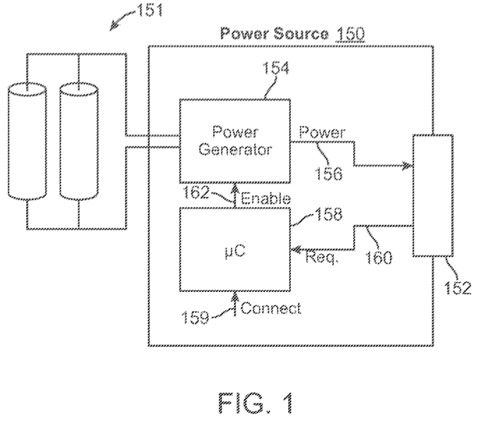Apple may be considering making its own portable power supplies. An company patent (number 20100327664) for a portable power source to provide power to an electronic device via an interface has appeared at the US Patent & Trademark Office. It relates to portable power sources and, in particular, relates to a portable power source operable to selectively provide power to a device connected to an interface of the portable power source.
The portable power source cooperates and communicates with the electronic device via a peripheral bus to which the electronic device is attachable. The portable power source includes circuitry to process a power request signal from the electronic device to determine whether a device connected to a bus interface of the portable power source is requesting power from the portable power source. The inventors are David John Tupman, Doug M. Farrar, Joseph R. Fisher Jr., Jesse L. Dorogusker and Donald J. Novotney.
Here’s Apple’s background and summary of the invention: “Portable electronic devices, such as Portable Digital Assistants and media players, typically include one or more rechargeable batteries housed permanently (or somewhat permanently) within the portable electronic device. These portable electronic devices sometimes also have peripheral bus ports that are able to support peripheral buses, such as Universal Serial Bus (USB) or FireWire (IEEE 1394) bus ports. Peripheral buses are used to provide data communications with electronic devices as well as to provide limited amounts of power to the electronic devices. The power typically originates from a host computer to which the electronic device is connected via the peripheral bus.
“In some situations, it can be impossible, or very inconvenient, to recharge the internally-housed batteries of a portable electronic device. This is typically due to lack of access to a suitable source of power. For example, many airliners do not have available a source of power suitable to recharge batteries of portable electronic devices.
“On the other hand, external batteries (e.g., disposable AA batteries) can be somewhat easily obtained and carried to operate a portable electronic device in situations where the internally-housed rechargeable batteries are discharged and a source of recharge power is not conveniently available. However, configuring a portable electronic device to accommodate the use of both external batteries and internally-housed rechargeable batteries can be detrimental to the portability of the device. Thus, there is a desire to accommodate the use of external batteries with portable electronic devices, while minimizing the detrimental effect to the portability of the electronic devices.
“Broadly speaking, in accordance with one aspect, a portable power source is configured for use with an electronic device. The portable power source cooperates and communicates with the electronic device via an interface to which the electronic device is coupled. The portable power source includes circuitry to process a power request signal from the electronic device to determine whether a device connected to an interface of the portable power source is requesting power from the portable power source.
“Typically, even if the connected electronic device has an internally-housed rechargeable battery, the internally-housed battery may be completely discharged. Thus, in accordance with some aspects, under some conditions, the portable power source provides power to the electronic device for at least a predetermined amount of time without consideration of the power request signal. The electronic device can use the power provided from the portable power source during this predetermined amount of time to boot up or otherwise arrive at a steady state condition, if not already at a steady state condition, so the electronic device can definitively determine whether to provide the power request signal to the portable power source.
“An example of a condition under which the portable power source may provide power to the electronic device without consideration of the power request signal includes an initialization condition, in which the portable power source is unaware of the state of the electronic device.
“An initialization condition may include, for example, a condition when electronic device is first connected to the portable power source after being not connected or, regardless of whether the electronic device is already connected to the portable power source, when external batteries are first inserted into the portable power source.
— Dennis Sellers

